

Simulacra and Simulation. Simulacra and Simulation (French: Simulacres et Simulation) is a 1981 philosophical treatise by Jean Baudrillard seeking to interrogate the relationships among reality, symbols, and society.
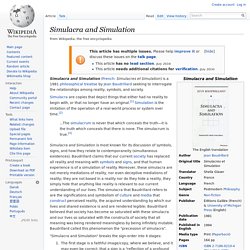
Simulacra are copies that depict things that either had no reality to begin with, or that no longer have an original.[1] Simulation is the imitation of the operation of a real-world process or system over time.[2] ...The simulacrum is never that which conceals the truth—it is the truth which conceals that there is none. The simulacrum is true.[3] Skeuomorph. A skeuomorph /ˈskjuːəmɔrf/ is a derivative object that retains ornamental design cues from structures that were necessary in the original.[1] Examples include pottery embellished with imitation rivets reminiscent of similar pots made of metal[2] and a software calendar that imitates the appearance of binding on a paper desk calendar.[3] Definition and purpose[edit] Skeuomorph is compounded from the Greek: skéuos, σκεῦος (container or tool), and morphḗ, μορφή (shape).
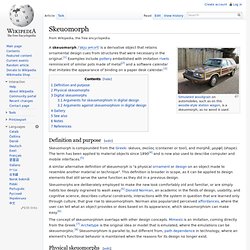
The term has been applied to material objects since 1890[4] and is now also used to describe computer and mobile interfaces.[5] Extropianism. Extropianism, also referred to as the philosophy of Extropy, is an evolving framework of values and standards for continuously improving the human condition. Extropians believe that advances in science and technology will some day let people live indefinitely. An extropian may wish to contribute to this goal, e.g. by doing research and development or volunteering to test new technology. Sense-model-plan-act. Martin Heidegger. Blindsight. Blindsight is the ability of people who are cortically blind due to lesions in their striate cortex, also known as primary visual cortex or V1, to respond to visual stimuli that they do not consciously see.[1] The majority of studies on blindsight are conducted on patients who are blind on only one side of their visual field.
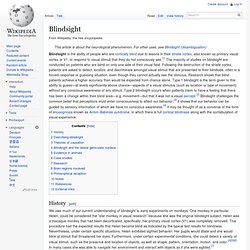
Following the destruction of the striate cortex, patients are asked to detect, localize, and discriminate amongst visual stimuli that are presented to their blindside, often in a forced-response or guessing situation, even though they cannot actually see the stimulus. Research shows that blind patients achieve a higher accuracy than would be expected from chance alone. Type 1 blindsight is the term given to this ability to guess—at levels significantly above chance—aspects of a visual stimulus (such as location or type of movement) without any conscious awareness of any stimuli. History[edit] A similar phenomenon was also discovered in humans. In 1995 Dr. GOFAI. In artificial intelligence research, GOFAI ("Good Old-Fashioned Artificial Intelligence") describes the oldest original approach to achieving artificial intelligence, based on logic and problem solving.
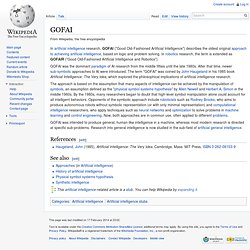
In robotics research, the term is extended as GOFAIR ("Good Old-Fashioned Artificial Intelligence and Robotics"). GOFAI was the dominant paradigm of AI research from the middle fifties until the late 1980s. After that time, newer sub-symbolic approaches to AI were introduced. The term "GOFAI" was coined by John Haugeland in his 1985 book Artificial Intelligence: The Very Idea, which explored the philosophical implications of artificial intelligence research. GOFAI was intended to produce general, human-like intelligence in a machine, whereas most modern research is directed at specific sub-problems. Deixis. Person deixis, place deixis and time deixis Types of deixis[edit] Traditional categories[edit] Possibly the most common categories of contextual information referred to by deixis are those of person, place, and time - what Fillmore calls the “major grammaticalized types” of deixis.[4] Person[edit]
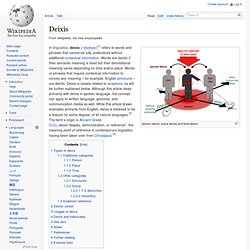
Subsumption architecture. Subsumption architecture is a reactive robotic architecture heavily associated with behavior-based robotics.
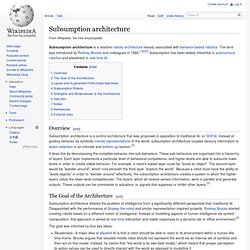
The term was introduced by Rodney Brooks and colleagues in 1986.[1][2][3] Subsumption has been widely influential in autonomous robotics and elsewhere in real-time AI. Overview[edit] Sensor fusion. Sensor fusion is the combining of sensory data or data derived from sensory data from disparate sources such that the resulting information is in some sense better than would be possible when these sources were used individually.

The term better in this case can mean more accurate, more complete, or more dependable, or refer to the result of an emerging view, such as stereoscopic vision (calculation of depth information by combining two-dimensional images from two cameras at slightly different viewpoints).[1][2] The data sources for a fusion process are not specified to originate from identical sensors. Michael Polanyi. Michael Polanyi, FRS[1] (11 March 1891 – 22 February 1976) was a Hungarian polymath, who made important theoretical contributions to physical chemistry, economics, and philosophy.

He argues that positivism supplies a false account of knowing, which if taken seriously undermines our highest achievements as human beings. His wide-ranging research in physical science included chemical kinetics, x-ray diffraction, and adsorption of gases. He pioneered the theory of fiber diffraction analysis in 1921, and the dislocation theory of plastic deformation of ductile metals and other materials in 1934.
He emigrated to Germany, in 1926 becoming a chemistry professor at the Kaiser Wilhelm Institute in Berlin, and then in 1933 to England, becoming first a chemistry professor, and then a social sciences professor at the University of Manchester. Biosemiotics. Definition[edit] Biosemiotics is biology interpreted as a sign systems study, or, to elaborate, a study of Approaches[edit] Furthermore, by providing new concepts, theories and case studies from biology, biosemiotics attempts to throw new light on some of the unsolved questions within the general study of sign processes (semiotics), such as the question about the origin of signification in the universe.
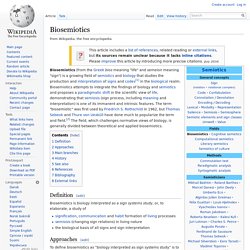
Charles Babbage. Logic gate. Homeostat. Cybernetics. Structural coupling is the term for structure-determined (and structure- determining) engagement of a given unity with either its environment or another unity.
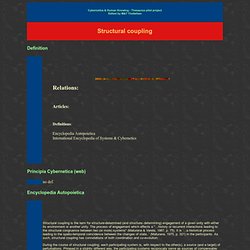
The process of engagement which effects a "...history or recurrent interactions leading to the structural congruence between two (or more) systems" (Maturana & Varela, 1987, p. 75). It is ‘...a historical process leading to the spatio-temporal coincidence between the changes of state..’ David Rokeby. David Rokeby at the unveiling of the work Cloud (2007) David Rokeby (born 1960 in Tillsonburg, Ontario) is an artist who has been making works of electronic, video and installation art since 1982. david rokeby His early work Very Nervous System (1982–1991) is acknowledged as a pioneering work of interactive art, translating physical gestures into real-time interactive sound environments.
Very Nervous System was presented at the Venice Biennale in 1986. Socially distributed cognition. Distributed cognition is a psychological theory that knowledge lies not only within the individual, but also in the individual's social and physical environment. This theory was developed in the mid-1980s by Edwin Hutchins. Using insights from sociology, cognitive science, and the psychology of Vygotsky (cf. cultural-historical psychology) it emphasizes the social aspects of cognition. It is a framework for studying cognition rather than a type of cognition.
This framework involves the coordination between individuals, artifacts and the environment. It has several key components: Enaction. Francisco Varela. Neuroethology. Neuroethology (from Greek νεῦρον neuron, "nerve" and ἦθος ethos, "habit or custom") is the evolutionary and comparative approach to the study of animal behavior and its underlying mechanistic control by the nervous system.[1][2][3] This interdisciplinary branch of behavioral neuroscience endeavors to understand how the central nervous system translates biologically relevant stimuli into natural behavior.
Systems theory. Hubert Dreyfus. Hubert Lederer Dreyfus (born October 15, 1929) is an American philosopher and professor of philosophy at the University of California, Berkeley. Cartography. Difference engine. A difference engine is an automatic mechanical calculator designed to tabulate polynomial functions. Fractal. Science, technology and society.
Chaos theory. Computational complexity theory. Science wars. Actor–network theory. Butterfly effect. Menger sponge.